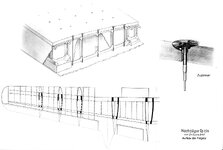Shortround6
Major General
Thank you. I have no good sources for the Ta-154.I've taken a peek on the German Wikipedia. They list V1, V2, V5, V6, V7 and V9 as being powered by the 211s, and, if I'm reading it right, the V5 and V6 were later outfitted with the 213As. V3, V8, V10 and V23 were outfitted from the get go with 213As. The V22 gotten the 213F. They don't list any Ta 154 with 213E. There was no V11 to V21.
FWIW
added: As far as pre- or small-series 154A-0 and A-1 go, these were exclusively powered by Jumo 211 engines.
I don't know why they didn't stick fuel tanks in wings. DH did it but many fighters with wooden construction did not. Wooden spars and ribs take up more room and when you start making the wing smaller even if you keep the same "thickness" you get a thinner wing.It seems that no fuel tanks were installed in the wings, so that is where a good deal of fuel can be crammed in so there is space for the 2nd crew member and a more serious bomb bay.
Obviously, in a fighter version, bomb bay should house the guns.
A-20 used 18% airfoil at the root. had a 464sq ft wing and could hold 400 US gal in the wing tanks, inboard and outboard of the Nacelles. Any increases in fuel were in the fuselage above the bomb bay.
And bombers were not meant for fighter maneuvers. The wings were not built to handle high G loads. This may have been a problem for some of the German planes, how soon did they drop the dive bomber nonsense for the twins? And you may not be able to just lighten a wing like you can just not bolt on the Dive brakes. trying to use lighter spars, ribs, stringers and even thinner skin in places calls for an awful lot of new calculations. If you get rid of the dive bomber requirement early all is great. If you are trying to make a high speed bomber and at least a daylight bomber interceptor (forget dog fighting escorts) you need more structure than just a high speed bomber/recon aircraft.
Ju-88 used a 586 sq ft wing and held 369 Imp gal( 443 US gal) in the wings.
Not saying you can't fit any, But a 350 sq ft doesn't leave a lot of room compared to the larger wings.
Well, I can see a smaller load (Do 217 could hold a max of 4000kg) but 1800kg is a bit fine.I'm willing to let go of the big bomb load the Do 217E-2 carried - instead of 3000, maximum can be 1800 kg. I'm also letting go of the numerous crew member count, their sizable glasshouse canopy, and I will cut the defensive firepower by at least a half.
The numerous crew members is four. cutting to three?
If you cut the crap defensive firepower by half does that give you 1/2 crap or twice crap
Yes ditch the fixed 15mm MG 151.
A single 13mm MH 131 out the top and 2nd one out the bottom is certainly crap. A single 7.9 out the nose isn't worth much and the single 7.9 out each side of the canopy that have to manned by either the top gunner or the bottom gunner seem to be a poor return on investment.
Germans had a real thing for acrobatic gunners leaping around the airplane from one gun station to the next while woefully slow interceptors tried to amble by the German bombers

